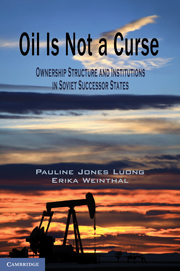Book contents
- Frontmatter
- Contents
- Tables
- Figures
- Maps
- 1 Rethinking the Resource Curse
- 2 Why Fiscal Regimes
- 3 State Ownership with Control versus Private Domestic Ownership
- 4 Two Versions of Rentierism
- 5 Petroleum Rents without Rentierism
- 6 State Ownership without Control versus Private Foreign Ownership
- 7 Eluding the Obsolescing Bargain
- 8 Revisiting the Obsolescing Bargain
- 9 Taking Domestic Politics Seriously
- 10 The Myth of the Resource Curse
- Appendix A List of Authors’ Interviews
- Appendix B Variation in Ownership Structure in Developing Countries
- Appendix C Responses to Select Life in Transition Survey (LiTS) Questions by Age Group
- Appendix D Ranking Basis for Determining which Countries are Included in Our Database
- Works Cited
- Index
6 - State Ownership without Control versus Private Foreign Ownership
Published online by Cambridge University Press: 05 June 2012
- Frontmatter
- Contents
- Tables
- Figures
- Maps
- 1 Rethinking the Resource Curse
- 2 Why Fiscal Regimes
- 3 State Ownership with Control versus Private Domestic Ownership
- 4 Two Versions of Rentierism
- 5 Petroleum Rents without Rentierism
- 6 State Ownership without Control versus Private Foreign Ownership
- 7 Eluding the Obsolescing Bargain
- 8 Revisiting the Obsolescing Bargain
- 9 Taking Domestic Politics Seriously
- 10 The Myth of the Resource Curse
- Appendix A List of Authors’ Interviews
- Appendix B Variation in Ownership Structure in Developing Countries
- Appendix C Responses to Select Life in Transition Survey (LiTS) Questions by Age Group
- Appendix D Ranking Basis for Determining which Countries are Included in Our Database
- Works Cited
- Index
Summary
We need to use transparency in revenue and financial management to allow people to hold government to account and build public trust … but companies have an interest in promoting transparency too. Transparency should help companies to reduce reputational risk, to address the concerns of shareholders and to help manage risks of long-term investments. And transparency is a positive contribution to development as it increases the likelihood that revenues will be used for poverty reduction.
– Prime Minister Tony Blair commenting on EITI, London, 2003Corporations … are increasingly being asked to step into roles that were once the domain of governments or international bodies such as the UN.
– Jim Buckee, CEO Talisman Energy, cited in Kobrin (2004, 455)In the preceding chapters we make a general case for the importance of ownership structure in understanding the relationship between mineral wealth and fiscal regimes over time. To recap, we argue that a country’s choice of ownership structure over mineral wealth rather than mineral wealth per se is responsible for the negative outcomes that are so prevalent in mineral-rich states. Ownership structure, however, does not exist in a historical vacuum, but rather, within a specific international context. Because petroleum is such an important international commodity, the influence of actors and norms outside the domestic arena is often unavoidable. This is most apparent where foreign investors (hereafter, FIs) are directly involved in the exploitation of mineral reserves; that is, when governments adopt the two remaining ideal types of ownership structure – state ownership without control (S2) and private foreign ownership (P2).
Indeed, the heightened role of FIs sets S2 and P2 apart from the other two ideal types discussed in Chapter 3 (S1 and P1) in two equally important ways. First, they can only produce fiscal regimes that are partially constraining and enabling – or what we call “hybrid” – because their primary influence is within the mineral sector – that is, on the size, stability, composition, and degree of transparency of the FIs’ fiscal burden, which, in turn, can affect both the quality of citizens’ daily lives and the long-term developmental prospects of mineral-rich states. Second, their effect on fiscal regimes is dynamic. As different actors gain and lose prominence in this sector at the international level, they can transform the impact of ownership structure itself on the triadic relationship between the primary direct claimants to the proceeds from mineral wealth (here, FIs) and the primary indirect claimants (here, governing elites and their societies). More specifically, changes at the international level mediate the direct effects of ownership structure on the three mechanisms we identify in Chapter 3: (1) transaction costs (hereafter, TCs), (2) societal expectations, and (3) power relations. The purpose of this chapter is both to enumerate the distinct effects of S2 and P2 on fiscal outcomes in mineral-rich states and to elucidate how their effects vary over the course of the twentieth century with particular emphasis on the most recent time period (1990–2005).
- Type
- Chapter
- Information
- Oil Is Not a CurseOwnership Structure and Institutions in Soviet Successor States, pp. 181 - 218Publisher: Cambridge University PressPrint publication year: 2010



